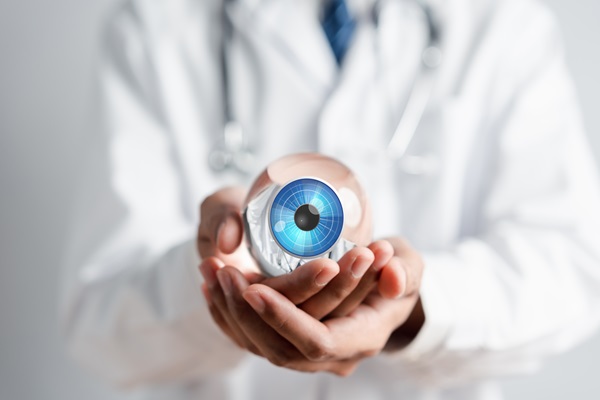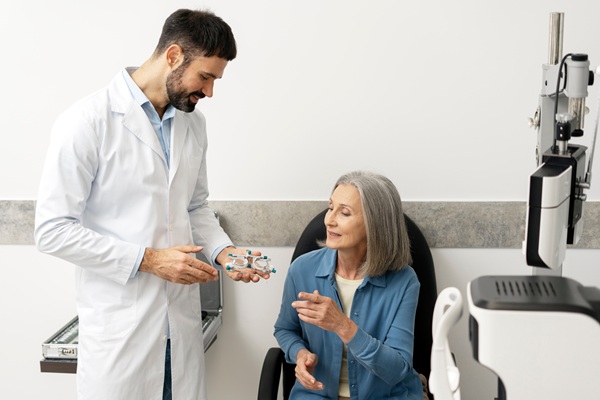What Happens During a Comprehensive Vision Test?

Simply put, a vision test checks the performance and health of the eyes. Everyone, from children to adults, should receive an exam, with their age determining how often one is necessary. If you have never undergone a vision test, review this article on what to expect during a visit to our office.
An Overview of a Comprehensive Vision Test
A vision test is a blanket term that encompasses many tests we perform during the appointment. Its purpose is to diagnose, prevent, treat, and manage any condition that threatens the eye's health and function.
Visual acuity
A visual acuity test is most likely what patients think of when scheduling a vision test. The primary aim is to determine how well a patient can identify small letters or numbers. It involves the patient standing at a pre-marked spot approximately 20 feet away from a Snellian chart, sometimes called the "Big E" chart. From the pre-marked spot, our team will ask the patient to read specific lines on the chart that get smaller with each line. We will also ask that they cover one eye at a time while reading. For small children who have yet to learn their letters fully, our team may hold up numbers on their hands or small pictures.
Visual field test
According to the American Academy of Ophthalmology, the primary purpose of the visual field test is to evaluate the patient's peripheral scope or view. The peripheral scope is how much the patient can see from the corner of their eyes without turning their head. We may place various objects, such as a pen or small ball, on each side of the face and move them. The patient's responsibility will be to keep their head still while telling us when the object is no longer in view.
Cover Test
Per the American Academy of Opthalmology, the cover test is the gold standard for determining the presence or absence of strabismus or ocular misalignment. Simply put, we need to determine how well the patient's eyes work together. This portion of the vision test involves using a small, dark-colored, opaque, or translucent occluder (which looks like a tiny paddle) to cover one eye at a time. This occluder is held up in front of one eye for a few seconds before we remove it. The optometrist will quickly assess the eye's movements while trying to adjust. They will follow the same process for the second eye.
Autorefractor or aberrometer
The autorefractor and aberrometer are not part of everyone's vision test— only those who require prescription eyewear. The autorefractor or aberrometer estimates the patient's prescription type and strength for each eye by using devices that stabilize the patient's head to focus on the pupils. During the autorefractor, the device will use a yellow or red light to focus on the retina, determining the lens power. An aberrometer uses a specific type of technology known as wavelength technology to detect obscure vision errors using a light that travels over the entire eye.
Refraction
A refraction determines whether or not astigmatism, presbyopia, hyperopia, or myopia is present. This portion of the test uses a device called a phoropter in front of the eyes to show the patient various lenses. The optometrist shows the patient a series of letters in two different lenses, and the patient alerts them to which is clearer.
Slit lamp exam
The slit lamp exam involves using a biomicroscope or binocular microscope to examine the full structure of the eyes. The patient will position their forehead and chin where directed on the machine. The optometrist will be on the other end, looking through the same device assessing the retina, cornea, conjunctiva, lens, and iris. This portion of the vision test can identify a wide range of eye diseases or conditions, such as cataracts, muscular degeneration, corneal ulcers, or diabetic retinopathy.
Tonometry
Sometimes called a puff-air test, a tonometry test detects glaucoma. Like with the slit lamp and autorefractor portion of the vision test, the tonometry will involve the patient placing their forehead and chin on predesignated spots on the machine. They will then see and focus on the light while a small puff of air enters their eyes. This is a painless and rather quick portion of the exam.
Dilation of the pupil
Before certain portions of the vision test, the optometrist will manually dilate the eye to garner a better view of the overall structure, including the optic nerve, retina, and blood vessels. They use an eye drop solution that takes around 20-30 minutes to begin working but may take a few hours to wear off. Therefore, the optometrist will provide a pair of glasses for the patient to wear upon returning home.
Schedule a vision test in the Dallas area
While it may seem like a lot in one appointment, each test is necessary to ensure your eyes are healthy and functioning properly. If it is time for your next vision test, contact our Dallas office for an appointment.
Request an appointment here: https://www.texasoptical.net or call Texas Optical at (214) 771-7333 for an appointment in our Dallas office.
Check out what others are saying about our services on Yelp: Read our Yelp reviews.
Recent Posts
Red, itchy eyes can affect your everyday comfort and reduce overall well-being. It is important to seek effective vision care from the first sign of irritation. Proper attention to symptoms, underlying causes, and healthy habits ensures stronger long-term eye health and greater day-to-day clarity. Redness and itchiness often stem from several common triggers. These include: Allergic…
New spots or shadows drifting across vision can be unsettling, and sudden changes sometimes require emergency eye care to protect long-term sight. Many floaters are harmless, but others signal serious problems with the retina or internal eye structures. Understanding when floaters are normal and when they point to a true eye emergency helps patients act…
Glaucoma treatment plays a vital role in preserving vision and protecting the optic nerve from further damage. Many patients rely on daily eye drops to manage intraocular pressure, but these medications can sometimes come with side effects. Understanding how to recognize, minimize, and communicate about these effects supports long-term success and comfort with treatment. While…
Progressive lenses offer clear vision at near, arm's length, and far distances without the visible lines found in bifocals. They provide a smooth change in power from top to bottom, which means the eyes can focus comfortably throughout the day. With the right fit and guidance from an optometrist, progressive lenses help reduce eye strain…


